The Village Voice

The Village Voice was a small newsletter published in Port Germein from December 1990 to December 1992 for 25 issues by Lucy Abbott, who had formerly lived at Terowie. She made an effort to include stories about the early days and people of the town, and had many good ideas, according to Norma Baker who supplied the following stories from the paper. Lucy moved to Tasmania with her seven cats in the early 2000s because her daughter lived over there.
One of her main sources of historical information was 85 year old Arn Miller, whose stories vividly brought to life the Port Germein of his youth. Many of those stories are included in this selection, together with other articles of historical significance. Illustrations in Village Voice were by Harm Folkers. Extra photos have been supplied by Norma Baker, Robert Shaw and the Pt Germein Museum.THE ARTICLES
- Port Germein Revisited
- A Myriad of Memories
- Walking Memory Lane
- Fun in High Street
- On the Bullocky Trail
- Orphan Jetty
- From Far Away They Came
- Wreck on Weeroona Island
- Building the Reservoir
- Jetty Ownership
- Mulligan Notebook
- Happy 86th Birthday
- 110th Anniversary of Church
- Saga of the Jessie Darling
PORT GERMEIN REVISITED
Edition 1, December 1990When Captain Niels Brinck walked along the streets of Port Germein in October this year (1990), he travelled back along memory lane to 1934.
Niels was an able bodied seaman aged seventeen when the Winterhude, captained by Uno Morn, berthed at Port Germein jetty to load bags of grain. TheWinterhude stayed at Port Germein for about six weeks. Niels has interesting memories of that time.
It was a long walk into town on off-duty periods, so the sailors devised their own mode of transport.
"We hoisted our shirts
to the grain trucks," said Niels, "and 'sailed' along the jetty into town. Our pay was two shillings and six pence per week."
"And how did they spend that handsome sum?" I asked.
"Well, it cost two shillings for a bottle of plonk and sixpence for a
packet of cigarettes. We'd sit down near the jetty, drink the plonk, smoke the cigarettes and then return to our ship. A young
sailor's pay didn't provide for much entertainment."
Sometimes the lads could hunt up a few pennies to put in the juke box at the dance palais on the beach. Niels recalled that his favourite tune was 'Louisianna.'
Because of the Winterhude's prolonged stay at the jetty, its crew became well known in the town.
"We had a wonderful
arrangement with the local policeman," said Niels. "We didn't bother him and he didn't bother us."
When the time came for their ship to depart, it was the policeman who organised a grand farewell party for the crew.
"The
townspeople all brought food along and it was a wonderful send-off."
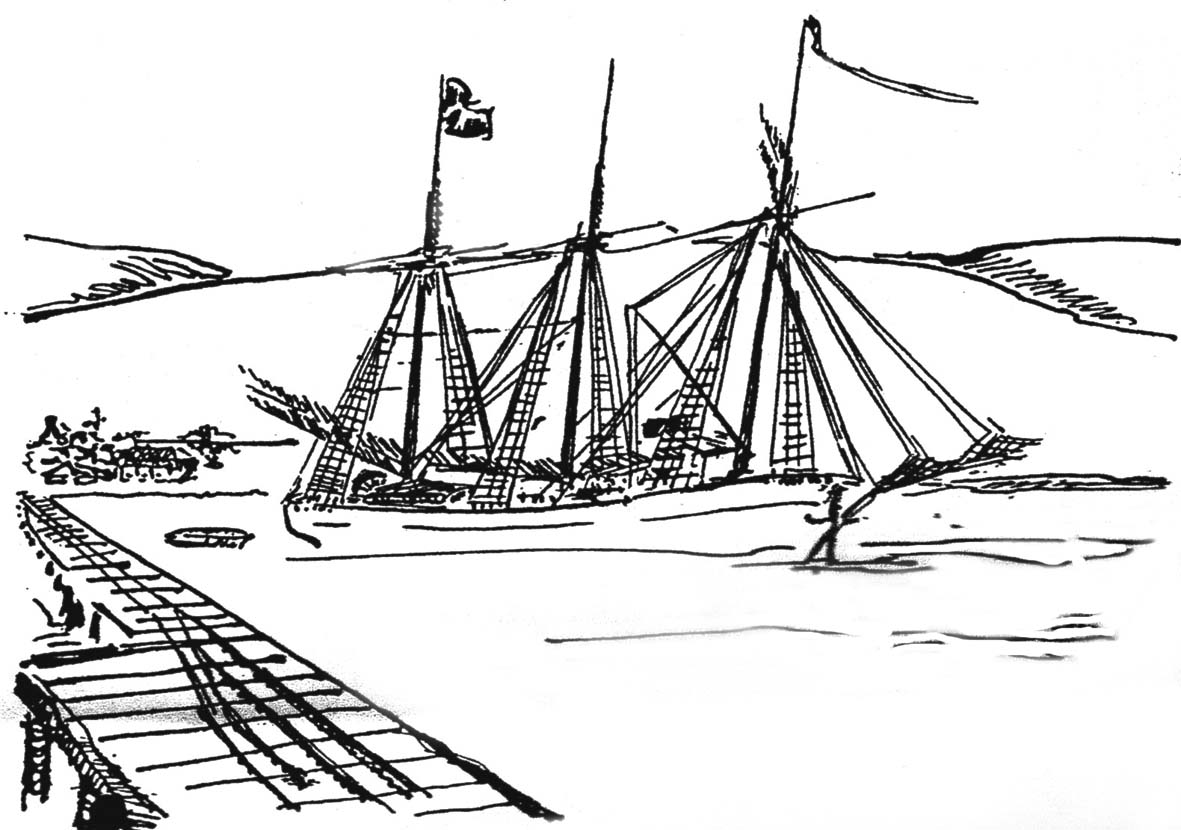
Niels has now retired from the high seas where he captained several Danish ships. But those adventure-filled able-bodied-seaman days occupy a special place in his crowded bank of memories.
One vivid memory relates to
a time when he went with a companion to complain to the Captain about the salt beef being 'a bit off.' The steward, who removed the
offending meat, replaced it with other food-one quarter pound tin of pineapple between eighteen sailors.
"It was the last time
we complained about anything," said Niels. "The navy has its own way to deal with insubordinate sailors."
On page three, in a letter, Niels Brinck said:
It was very nice to return to Port Germein after fifty six years. It brought
back a lot of pleasant memories. How little it has changed. I could see the sailing ships at the jetty in my mind.
Thank you for being so kind to us and opening the museum just for us.
In 1934 the following ships were in Port Germein-
Three
masted barque-
Winterhude (my ship)
Four masted barque-
L'Avenir
Four masted
barquentine-
Mozart
all at the same time and all loading wheat in bags.
Captain N. S. Brinck
Peakhurst, NSW
A MAN WITH A MYRIAD OF MEMORIES
Edition 1, December 1990 Arnold Miller probably knows more than anyone about the town and district of Port Germein. He was born in a cottage on
Port Augusta Road in 1905 - seventh child in a family of ten. The Miller family moved to Baroota and Arnold's first introduction to
formal education was at the tiny Baroota Creek School on Dennis's property. When that school closed it was a four mile walk to
Baroota. Arnold later attended Port Germein School, travelling by horse-drawn vehicle.
Arnold Miller probably knows more than anyone about the town and district of Port Germein. He was born in a cottage on
Port Augusta Road in 1905 - seventh child in a family of ten. The Miller family moved to Baroota and Arnold's first introduction to
formal education was at the tiny Baroota Creek School on Dennis's property. When that school closed it was a four mile walk to
Baroota. Arnold later attended Port Germein School, travelling by horse-drawn vehicle.
Arnold remembers the old race-course, which closed about 1920. He once drove his horse and sulky to the races on the way home from school. Pupils had been let out early that day - maybe the teacher wanted to attend the races too.
Miller family roots are firmly entrenched in Port Germein and district. The Beach Hotel was built in 1878 for Sam Miller, Arnold's grandfather. His father, Tom, had a garage in Port Germein, where the town's first petrol pump was installed about 1925. Petrol had previously been sold in cans.
Recollections of the early township, the grain trade, shipping and a myriad of other memories are stored within Arnold Miller's mind. In each edition of Village Voice, we will run a feature story on some facet of his life.
Edition 2, January 1991
Although only eight years old at the time, Arnold clearly remembers the 1914 drought.
"The
dust rolled down the hills like fleeces of wool - the animals died or had to be destroyed because there wasn't a scrap of food left
for them."
Arnold can describe early Port Germein buildings, some that have completely vanished, including an old grass shed opposite the Police Station. He remembers when creeks ran through the Caravan Park.
When he was about fourteen, Arnold left school and went 'nippering.' The Baroota Reservoir was being built and many men worked there after World War 1. When Arnold worked on the waterline, one of his jobs was to clean the pipes. This required crawling through 18 inch pipes - about a mile of them. The 16 inch ones were too small, so a sand bag on a wire was used.
Arnold was about nineteen when he started as an agent on the wheat trade. Port Germein was an important port of export for grain. He married Irene Richens when he was twenty seven.
Although he worked for a year at Port Lincoln during the depression, he was involved in Port Germein's grain trade for forty years.
WALKING PORT GERMEIN'S MEMORY LANE WITH ARNOLD MILLER
Edition 4, March 1991In the late 1920s-early '30s, about the time when a violent thunderstorm knocked the chimney off the Post Office, and killed two of Wilson's horses, Arnold was a a young man.
As he turned back the pages of time, we crossed the wooden bridge over Baroota Creek on the old Gorge Road and walked past the local pound on the creek bank to the left. Off to the right was the Aboriginal camp.
Near the Institute, teamsters and horses with loaded vehicles were waiting at the weighbridge on the left. Across the road sparks flew from Jack Tindal's forge. Keeping to the left-hand side of High Street, we paused to glance in the windows of Billy William's butcher shop and Wally Richens' grocery establishment.
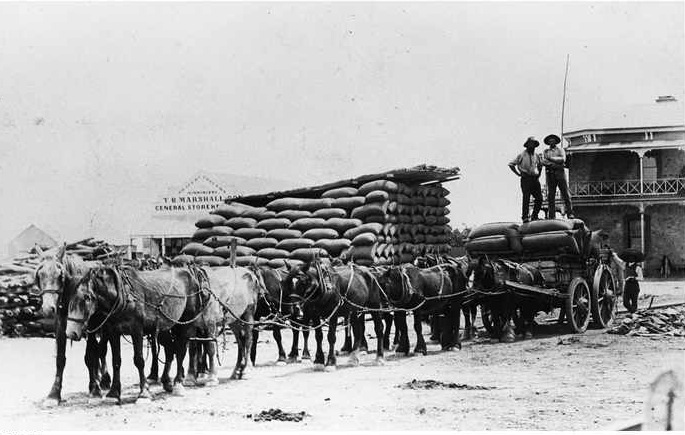 Farmers' Union wheat stacks and large shed were nearby. On we went, past a house,
Bowleys' carpenter shop, tennis courts, National Bank and soldiers' monumnet. Alf Flugge's garage was on the corner.
Farmers' Union wheat stacks and large shed were nearby. On we went, past a house,
Bowleys' carpenter shop, tennis courts, National Bank and soldiers' monumnet. Alf Flugge's garage was on the corner.
We moved on across the side road to watch activity at Mulligan's blacksmith shop where horses were waiting to be shod; then past the swamp to the chemist shop and Pier Hotel. We could now see the lighthouse at the jetty's end, and the dance Palais on the beach.
There was much activity around the open-ended goods shed, engine shed, coal bunker and the Harbour Master's office. A winch on the platform helped to load goods. Beside the winch some people sat on a large sleeper It was a popular gathering place known as 'The Log of Knowledge."
We crossed several lines of rail tracks to swamp ground on the other side of High Street and strolled past the wheat stacks to Daly's store-then crossed the road to the Port Germein Hotel. Along then to the grocer's shop which sold all sorts of things, including a meal for one shilling and three pence.
A garage with 'Plume' petrol for sale boasted of having the first petrol pump in the town. Into Petkey's shop which sold lollies and other things. Dahlenburg's feed store was next then a butcher's shop, bakehouse and Bessen's boot store.
We soon arrived at John Darling's wheat shed and stacks which covered a large area. Dreyfuss's stacks occupied the corner block.
We had now travelled along the sides of High Street. By the time we arrived back at the Institue, Port Germein's gas lights were beginning to flicker - one directly in front of the Institute - others at the feedstore corner and near the wooden bridge on the Port Pirie road.
We stepped into the present again. Arnold
explained that after the wheat trade had declined he purchased John Darling's shed.
"I pulled it down and sold it to a soft
drink merchant, " he said.
FUN IN HIGH STREET
Edition 5, April 1991There was always plenty of activity around Port Germein's main street when the wheat trading was in full swing. Because Arnold was a wheat agent, he had a box seat from which to watch the show.
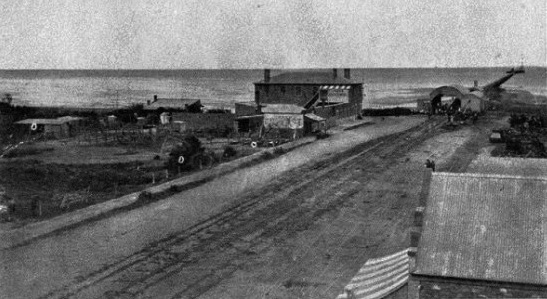 Lachlan McPhee, the Harbour master, was also engine driver. Arnold recalls the time
when the trucks jumped the points
in front of the bank. Off went the trucks in a wide arc across the road. It must have been Lachlan's lucky day - he put the engine
in reverse and the trucks obediently jumped back onto the rails.
Lachlan McPhee, the Harbour master, was also engine driver. Arnold recalls the time
when the trucks jumped the points
in front of the bank. Off went the trucks in a wide arc across the road. It must have been Lachlan's lucky day - he put the engine
in reverse and the trucks obediently jumped back onto the rails.
Hector McPhee, Lachlan's son, was not so fortunate. He was a mail carter who owned a Chev truck. All was fine driving along the jetty but when he tried to turn at the end, the rails caught the truck wheels - the vehicle hung over the edge of the jetty until pulled back to safety by a winch.
Clutterham was a wheat agent who also operated a baker's shop (it later became the four square store.) McPhee didn't get the trucks up early enough to suit Clutterham, so he decided to pull three trucks up behind his ute. The idea was fine, but he couldn't pull up at the points. The trucks then took the initiative and pulled the ute back the other way.
McPhee's fireman was known as 'Old Garleich' - (we think that's how to spell his name.) Garleich had set the points and had the empty trucks ready for the morning but someone shifted the points at night. The result was spectacular - Wheels went through the sleepers. Old Garleich lived in the house now owned by Robin Hutchinson, in Sixth Street. There were two posts in front. Local kids fastened wire across near the bottom of the posts. It was quite a 'come down' for Garleich when he returned home on his pushbike.
Les Tee was employed by Ditmar, the baker. Ditmar had prepared a batch of coffee cake which was spread out on the floor, carefully covered with bags. Les was a bit late for work - he came racing through the bakehouse at high speed. Customers probably wondered about the strange design on that day's coffee cake. Les Tee was an enthusiastic dough maker who was known to spread his talents far and wide - it was quite a common sight (so they say) to find dough on the ceiling after Les had been doing an extra good job.
Planks 22 feet long were used as ramps for hand carts to load bags onto the trucks. One teamster who was too impatient to wait, unharnessed two of his bullocks, hauled the planks away, re-harnessed his team and continued on his journey.
Spencer arrived in town after being caught in a thunder storm. "Where did you get wet, Mr Spencer?" asked a friend. "All over," was the quick reply.
Just a quick look into Dally's shop before leaving - its fine cedar counters and money container which ran across on a wire are well remembered by Arnold.
ON THE BULLOCKY TRAIL
Edition 6, May 1991It is a bright clear morning and there is much activity at the Miller home on Baroota Creek.
Tom Miller and his young son, Arnold, are yoking the bullocks to cart a load of wheat from Camerons of Murray Town to the wheat stores at Port Germein.
Jack and Curly, Noble and Smoker, Spot and Sharper, Nugget and Lively, Drummer and Delva, Darkey and Rattler are all impatient to get moving. Jack and Curley are leaders today -sometimes it's Noble and Smoker. The bullocks know the track through the gorge, so they make good time to Murray Town - they arrive about 4.00 pm and a well earned rest for bullocks and drivers.
It's up early again in the morning to water and yoke the team. The leaders are separated temporarily to pull the bags up onto the load.
Then begins the trip from Murray Town to the Gorge, with its long, slow haul. Jack and Curley are sure-footed as they negotiate the other bullocks and the heavy load over the 43 creek crossings.
Young Arnold (about 8 years old) takes a turn at driving, the long whip clutched firmly in his small hand.
As the team pulls out of the gorge it's just a short trip to Blieschke's place and the government dam. Here the bullocks are unyoked and taken home up the creek. The load is left to be picked up next morning.
Up early to take the team back to Blieschke's - re-yoke and begin the final stretch which delivers the load into Port Germein.
Jack and Curley are the leaders this trip but it's Darkey and Rattler at the rear who have the hardest job.It is a three day exercise for Tom Miller to bring in a load of wheat. But Tom understands his team - bullocks and driver work harmoniously when two loads are brought in each week during the season.
ORPHAN JETTY
Edition 6, May 1991Dear Editor,
During 1956 a Jetty Committee was formed in Port
Germein with the purpose of saving and preserving the Port Germein Jetty.
Out of those who attended this meeting the
following persons were selected (from people as far away as Peterborough and Broken Hill to as far North as Coober Pedy and Woomera
and West to Iron Knob and Kimba):
Chairman - Peter Prests; Councillors - Jack Hillam and Stan Holman; Secretary - Kevin
Mitchell; Committee Members - Ted Dennis, Henry Ottaway, Laurie Olsen. These people were to represent the people of Port Germein and
surrounding districts.
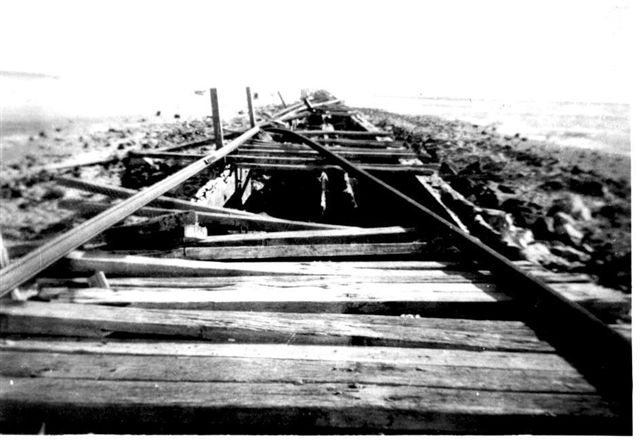 After much consultation and arguing with the Government of SA, and on the second trip to Adelaide, the
Committeee, with the then member for the district, Mr Len Ritchie of Port Augusta, confronted Mr Tom Playford, the (then) Premier
which resulted in the Premier offerieng the Port Germein Jetty and all amenities such as rail lines, engine, trucks, good shed etc.
to the District Council of Port Germein, plus £6000 for the repair of the jetty (with the exception of the lighthouse which
was to be separated by one section being removed from the main jetty, as this was to remain the property of the Harbours'
Board.)
After much consultation and arguing with the Government of SA, and on the second trip to Adelaide, the
Committeee, with the then member for the district, Mr Len Ritchie of Port Augusta, confronted Mr Tom Playford, the (then) Premier
which resulted in the Premier offerieng the Port Germein Jetty and all amenities such as rail lines, engine, trucks, good shed etc.
to the District Council of Port Germein, plus £6000 for the repair of the jetty (with the exception of the lighthouse which
was to be separated by one section being removed from the main jetty, as this was to remain the property of the Harbours'
Board.)
The Council readily accepted this offer. Surely there is record of this on file at the Council office as Mr Toby Foote, the then District Clerk, was very meticulous and would have made entry somewhere along the line.
After the jetty was repaired by voluntary labour and the sale of the rail lines and other material, the balance, approx. £12000 left over was handed over, together with books etc. to the District Council. It was stressed the Council invest the remaining funds at the best possible interest rate with the understanding that the money be made available for future repairs on demand. This was also agreed to.
I understand that at the final Jetty Meeting the Councillors advised that the £12000 was used to renovate and update the Council Chambers at Melrose and the Councillors assured us that the money would be made available if needed at the rate of 5% interest. Again I say that this also would have been recorded, being the former Secretary and being on the deputation to the Government. I have no doubt who owns the jetty - The District Council! Which makes it 'NOT ORPHANED.'
This was in response to a previous letter in the "Village Voice" about ownership of the jetty.E K Mitchell, postmaster of Port Germein for many years.
FROM FAR AWAY PLACES - THEY CAME TO PORT GERMEIN
Edition 7, June 1991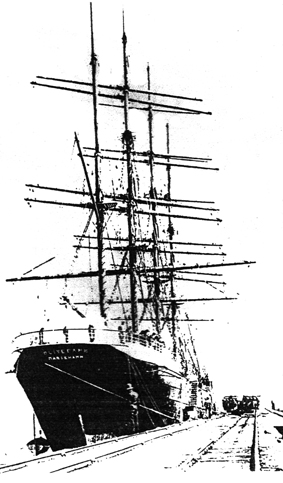 Tall masts of the Eriksen Line of Scandinavian ships are silhouetted against the skyline, their elegant figureheads
presenting an air of grace and dignity.
Tall masts of the Eriksen Line of Scandinavian ships are silhouetted against the skyline, their elegant figureheads
presenting an air of grace and dignity.
The "Olivebank" is waiting at the jetty to take on a load of bagged wheat. Captain Matsen (in photo below) is proud of his ship, and the crew will be kept busy during the two to three weeks in port while the cargo is being loaded.
Sails will be mended and all general maintenance attended to - the whole ship will be made spick and span.
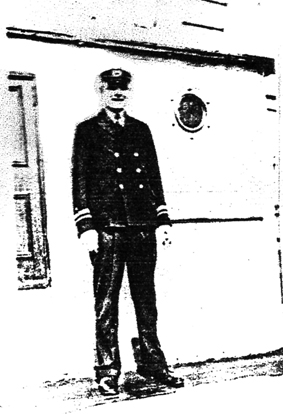 Down in High Street, the labourers have been wheeling bags up planks
and onto rail trucks since around 7 am. Huge grain stacks line the street around Farmers Union, Darlings and Drapers grain
stores.
Down in High Street, the labourers have been wheeling bags up planks
and onto rail trucks since around 7 am. Huge grain stacks line the street around Farmers Union, Darlings and Drapers grain
stores.
Arnold Miller understands the procedure very well - he has been a grain agent for many years, and now in 1940 he has watched the loading process a countless number of times.
Sixty five bags are loaded onto each of the seven trucks which will be pushed by the small engine, working in the rear, out to the waiting ship. Twenty one trucks and two engines keep up a continuous haul. Empty trucks are pulled back with the engine in front.
First stop on the way out to the ship is at the coal bunker near the goods shed - then off out along the jetty. The tide is out this morning so the ship is down.
This means that the bags can chute straight down into the ship from the trucks. When the tide is in and the ship is riding high,
slings are placed around the bags and a winch on board the ship pulls them up to the chute.When loading has been completed -
about thirty to forty thousand bags, the "Olivebank will be ready to leave on the long journey home - several months will be spent
at sea.
The tide is out this morning so the ship is down.
This means that the bags can chute straight down into the ship from the trucks. When the tide is in and the ship is riding high,
slings are placed around the bags and a winch on board the ship pulls them up to the chute.When loading has been completed -
about thirty to forty thousand bags, the "Olivebank will be ready to leave on the long journey home - several months will be spent
at sea.
If the East wind is blowing when the "Olivebank" is ready to depart, she will move off under her own sail, otherwise a tug from Port Pirie will pull her out into the channel.
When sailing ships were in port at Port Germein, it was common practice for the captain to purchase live pigs from local farmers. This ensured a supply of fresh meat during the long period away from land.
THE WRECK ON WEEROONA ISLAND
Edition 8, July 1991The poor old thing was not driven ashore in a howling gale, she wasn't scuttled by pirates or anything very romantic at all. At the end of a long, useful life she was just left on the beach to die. Officialdom will tell you that she was sold for demolition in 1922 and was completely demolished by the 1930s; not so, she still had her decks in the 1950s.
'Tis said that she carted stone from the Island to Pirie for a while and was later sunk in her present position and used as a wharf to accommodate small vessels or barges while they loaded stone for Pirie.
She was the iron built lighter "York," date and place of building not known. She was built in sections and reassembled in Albany Western Australia in the early 1860s; she was sold to the Adelaide Steamship Company in 1877; she was fitted with masts and sails and sailed to Port Adelaide. There was quite a barney with the powers that be, or were, anyway, when it was discovered that she had made the voyage without an anchor aboard.
She was used around Port Adelaide for some years and later sent to Pirie as a coal hulk. She was sold in 1922 to Clem Pilbern who had the ketch "Plank Point" which brought fire wood to Pirie from the other side of the gulf.
Contributed by Noel SmithBUILDING THE RESERVOIR
Arnold was just a young chap when the Baroota Reservoir was being constructed and he was 'nippering' on the jobMaterials were brought to Port Germein Jetty by ship which came in once a fortnight. Early on Monday morning the Harbour Master would go down with the engine and trucks to load the supplies from the "Paringa" which called in at various ports on the way to Port Augusta. It arrived at Port Germein at about 5.00am.
The "Paringa" brought in supplies for the town - several businesses were operating in Port Germein at that time. She also carried a few passengers.
The loaded trucks came to the goods' shed where teams of up to sixteen or eighteen horses were waiting with their wagons to load cement and other supplies for the Reservoir job. It was a long slow haul up the hill to Baroota. The horse teams would take back wool and other goods for the "Paringa's" return trip.
Max Steinburg operated a shop at the Reservoir. The shop had a cellar where Max kept his hop beer. Local farmers and Reservoir workers all agreed that it was 'great stuff.' Max's shop was originally in Dennis's paddock, but was later moved down to the creek.
Arnold worked for a while at the boarding houses (Sherriff's and Corbert's) which catered for the workers. Carting wood by horse and cart to keep up the supply and cooking breakfast porridge were among his tasks.
PORT GERMEIN JETTY OWNERSHIP
The May edition of the Port Germein "Village Voice" suggests that the Council does have ownership of the Port Germein Jetty and the following comments are intended to clarify this matter.
The research undertaken during the time of the "Quite Remarkable' History Book revealed the following - 'In June 1954 the Council protested against the demolition of the Port Germein Jetty proposed by the Harbours Board. In 1957 the Council accepted responsibility of the Jetty and Reserve and was granted £6000 and a Government grant to assist in repairing the jetty. In 1976/77 Council once again repaired the Jetty and the State Government subsidised 80% of these works.'
At that time the ownership of the jetty was returned to the State Government and the Council was obliged to contribute 20% towards annual maintenance costs of the jetty. This 20% contribution by the Council has been apparently overlooked, as we were not required to contribute to recent maintenance work.
If Marine and Harbours were able to demonstrate by agreement, that the jetty was owned by the Council, then they surely would have by now. Marine and Harbours state the intention clearly that the policy of the Department was to hand over recreational jetties to local government. (Port Germein was no longer classed as a harbour after 1961.) This transfer appears to have never been done.
Clearly the Council would fight for the retention of the Jetty should the State again try to demolish the Jetty. However, to accept total responsibility for the Jetty would have financial implications beyond our capacity!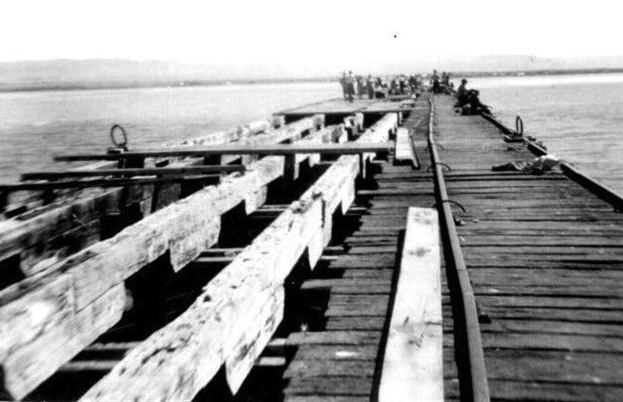
From Council Minutes: Ref
"Quite Remarkable" Griffiths 1986, page 201.
MULLIGAN NOTEBOOK - THE JETTY
The following hand-written pages are from a notebook found among
the possessions of the late Kath and George Mulligan. Mrs Mulligan died on June 24, 1991. Bryan Robertson and his wife Dorothy (nee
Mulligan) sent a photo-copy of the original to the "Village Voice."
The name Mulligan was well known in Port Germein. Alf and Charlie were both blacksmiths in the district. George was the son of Alf. George carried on the business which had been established by his uncle Charlie in High Street. Older residents remember how George was always ready to wage a price cutting war between his small store at the blacksmith's premises and that of another storekeeper named Smith across the road.
George Mulligan attended Port Germein Primary School. He later married Kath Moyes, daughter of a Port Germein resident. George, Kath and children lived for several years in a substantial stone home (still standing) at the corner or Havers Ave and Ninth Street.
I reproduce the first page of the notebook but will type it all out to reduce space. For the sake of authenticity, I will not edit out mistakes. Some words at the ends of lines were cut short. I will try to cross check names of ships, which are not always easy to read, with shipping lists in newspapers when time allows. (24/3/2012)
Page 1 Port Germein Jetty
Interesting Items and Particulars concerning the above Collected and recorded
by Mr H. Cobb who held the position of Post and Telegraph master and other accompanying official Appointments from July 1882 to June
1905. Also held the Position of Harbor Master and Sub Collector of Customs with other accompanying appointments from Feb 1895 to
June 1905
 1880/1 Port Germein Jetty under Construction by Mr John Wishart open for Traffic on July 17th 1881
1880/1 Port Germein Jetty under Construction by Mr John Wishart open for Traffic on July 17th 1881Handed over to Marine Board in March 1882 and worked by the Engineers Dept at first
Cost of first Contract £12,000 a further extension of 400 feet in length 30 feet wide was Completed by Wishart May 30th 1883 at a cost of £5000 Total length of Jetty now 5459 feet
Minister on Sea Isle of Shippey has the longest Peir in England Viz 7000ft
(NB I think this refers to a pier at
Minster on Sea, Isle of Sheppey. I have found the Kent
History Forum, an amazing repository of information,  and it seems that
this pier was never built though there was a reference to it in the "Burra Record" of 30-1-1907. LN 23/3/2012
)
and it seems that
this pier was never built though there was a reference to it in the "Burra Record" of 30-1-1907. LN 23/3/2012
)
During construction of the Jetty Mr Wishart had two Vessles alongside Discharging Piles for the Extension Viz one 400 and one 350 tons Register
March 12th 1884 Barquette Frey 450 Tons first Sailing Vessle to Berth alongside Jetty to load wheat cargo
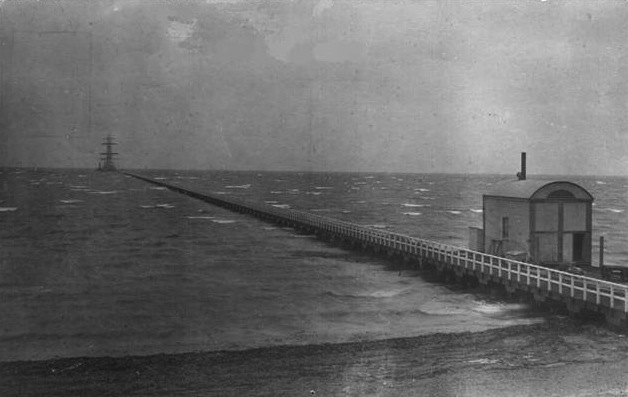
Sept 1884 Engine commenced running on the jetty
Nov 1884 Port Germein declared a port of import and export
July 1885 Total
Cost of jetty to date including rolling stock £19115-7-0
Feb 1886 Dredger completed excavating ships berth E side of
the jetty to 20 feetLW length of berth 300 feet Cost of work £454
Jan 26th 1888 Ship Rovola 1493 Tons first ship of
over 1000 tons to berth at Jetty
Airlie loaded her Complete Cargo and left the jetty on a draught of 20feet 10" later
Feby 18th 1891 Record busy day shipping at Jetty Sutley 1672 Tons Firth of Forth 830 Tons Karan Lira (?) Steamer 1630 Tons Investigator 345 Tons During the day 6000 bags of wheat and 50 Tons of General Cargo were shipped over the jetty
Feby 21st 1891 During the week ending today Jetty traffic Consisted of 23360 bags of wheat and 50 Tons of General Cargo (a Record)
1890 Ships City of Lucknow 1195 Tons loaded 9000 bags of wheat from the Thursday morning to 2 pm Saturday on another occasion Darling & Sons shipped 4000 bags of wheat during 12 working hours.
1892 Dredging opperations have now provided a dredged berth on E side to 22 feet LW thus increasing shipping accomadation as follows 600 feet with 22 feet LW. E. side 300 feet with 20 feet LW W Side channel leading out with 17 feet LW
1893 Ship Ellora 1589 tons completed loading at Jetty to 22 ft 3"
Feby 1894 Earl of Dunmore 2205 tons Registered the first 4 mast barque to visit this Port completed a full cargo at the Jetty and proceeded to the Anchorage on a draught of 22 ft 6 "
Feby 1899 Alcyone 4M barque completed a full cargo and left on a draught 22 ft 6 " (a record)
Feb 1900 Dunfermline 4 M barque 2902 Tons Gross Register completed her loading at jetty consisting of 36997 bags 158084 bushells of wheat cleared for sea on a draught of 22 ft 5 " this is the largest cargo per Sailing Vessel and the largest SV loaded from a S. Aust Port up to Date
Jan 5th 1901 SS Hendrika 2167 tons Nett 3653 tons Gross loading at jetty from 26 Dec 1900 took in 24686 bags of wheat here having 17000 bags on board on arrival from Port Adelaide Total cargo on completion 41686 bags or 180428 bushells of wheat departed from jetty on a draught 22 ft 3"-this is therefore the largest cargo of wheat yet dispatched from SA which is our latest record 1901
During the year Jan to March the following Principal Shipments are noted: Winford 29678 bags Grocijon 29486 bags Orion 28802 bag Euterpe 28155 Mermurus 21098 bags besides others, the Jetty traffic during the month of Jan consisted of 48840 bags of wheat 1000 ton ships balast (Discharged at Shore end) 120 tons General Cargo producing ....
Edition 9, August 1991
Continued from Edition No. 8: a revenue of £501-14-1 Jetty tolls, Harbor charges Este this is the highest yet recorded. Previous highest monthly receiptsFeb 1891 £465-13-8
March 1893 £332-2-5
March 1894 £320-9-7
Jan 1901 £510-14-1
Jan 1904 £370-10-1
Aug 30th 1901 Dredge and barges completed cl and excavating E berth as follows 350 feet to 23 feet LW 250 feet to 22 feet LW western berth 300 feet to 22 feet LW
Sept to Dec 1901 New National Banl Built
Jan 27 1902 Holiday record Excursions Port Pirie to Port Germein SS Investigator 3 trips, Adela 2 trips Nelcebee 1 trip carrying about 3000 people who spent the day on the beach and Jetty
March 10th 1902 Busy day Ships Teresa 1300 tons Vera Jean 1824 tons on each side of Jetty and Hiawatha 1496 tons arrived and berth astern Teresa - Investigator also alongside Discharging Tug boat Adelaide arrived to tow out the Vera Jean
1902 Harvest a complete failure not a bushell of wheat will be exported from the Commonwealth this year all grown will be required for home consumption
Jan 1903 SS Kadina 1707 tons SS Time 2575 tons March SS Dilkera 2667 tons April SS Dilkera 2667 tons all loaded and consigned to Interstate Ports
Dredge here again to clear up and deepen channel to 17 ft 6 " then towed away to help opperations at Outer Harbor scheme
Nov 1903 Ship Hilston 1998 tons to load new seasons wheat this is the first wheat ship to load wheat for SA this harvest
Nov 9th Extremely low tide caused by strong North gale all day first reaping started Oct 10th and wheat is being shipped on coastal steamers as fast as it is delivered to Agents 1900 sent away by 31st and 11,300 bags by 19th Nov
Jan 3rd 1904 Abnormally high tide sea flowing over the Jetty highest ever experienced Caused by heavy SW Gale with spring tides 37 feet Depth of water in outer berth jetty end
Jan 15th SS Matin 2433 tons Nith 3828 tons Gross Sailed from Wallaroo with 175465 Bushells of wheat ('there' record Cargo) Germein still holds the best record
jan 13th to 16th Darling and Sons shipped 13104 bags on Ship Lorely During these 4 days smart despatch
March 1904 Barque Santo 900 tons arrived Monday in tow from Pt. Adelaide and Commenced loading as soon as moored alongside Jetty loading her full cargo of 10375 bags of wheat in 30 working hours this Vessel arrived in Port
Adelaide March 22nd Commenced Discharging 1500 tons general cargo which was all Clear early on Saturday 26th then took in 300 tons of wheat for stiffeneing was towed to Pt Germein loaded and completed by Wednesday 30th one week after arrived in Sth Aust Ports
June 1904 Ship Anemone 1595 tons loaded 21 ft draught towed out to Anchorage on half spring tide no difficulty experienced
Oct 1904 Holiday early Closers Picnic from Pt Pirie Steamers Adelaide, Eleanor, Florroe and Mermaid arrived with 1500 people on board a lovely day
Oct 24th Barque Fonteviot load at Pt Augusta Cargo 180842 Bushells of wheat thus beating Pt Germein record of 180428
Dec 22nd 1904 Ship Arranmore(?) 1946 Tons arrived alongside Jetty with full cargo of Super Phosphate Draught 21 ft 5" Discharged 450 tons then towed to Pt Pirie
March 14th 1905 Ship Vondel 1562 tons Ancaious 1704 tons at jetty loading Elfrieda 1714 tons arrived here in Balast traffic over Jetty for the month 45393 bags wheat 930 tons Balast 130 tons General Cargo Collectiosn £452-3-10 Total Collections account Jetty tolls Etc fot 4 months ending 25/4/05 £980-5-8 next highest totals for same Period 1888 £970-14-7 1901 £947-17-11 cost of jetty including repairs maintanance Jetty lines Etc to Sept 1905 £39701-14-3 annual totals of wheat shipped over Jetty in Bags
|
Year -- No. Bags |
Year -- Annual Jetty Revenue 1883 -- £597-1-2 1884 -- £1043-3-0 1885 -- £1671-1-0 1886 -- £346-6-4 1887 -- £895-14-1 1888 -- £1982-10-3 1889 -- £514-11-7 1890 -- £1373-13-2 1891 -- £1476-10-2 1892 -- £1006-3-9 1893 -- £1280-3-6 1894 -- £1543-8-5 1895 -- £986-19-7 1896 -- £592-7-6 1897 -- £366-17-0 1898 -- £488-10-0 1899 -- £977-18-8 1900 -- £1087-6-11 1901 -- £1793-4-3 1902 -- £899-2-1 1903 -- £609-18-0 1904 -- £1008-6-2 This ends the notes |
HAPPY 86th BIRTHDAY TO ARNOLD
Edition 10, September, 1991Best wishes to Arnold Miller who celebrated his eighty sixth on Sunday September 15. Eighty six years is a long time to be around the one area. Arnold has seen many changes along those years. People have come and gone - buildings have vanished or have been replaced.
There are just a couple of gnarled old fence posts on the block where Tommy O'Shannessy's house was situated at the corner of First and Fourth Streets, near the Methodist Church (now Uniting Church). Tommy, who was physically handicapped, had worked as a clerk on wheat-tallying but he is best remembered as the mail contractor.
Tommy's daughter Rose was a dressmaker who made sure that the local ladies were attired in style for all important occasions.
Tommy was a Ford fancier in the 1920s. He used his Ford truck to bring in the mail from Port Pirie. On special occasions he used his Ford car. Young Sammy Tee worked for Tommy. he used to ride a pony out to Telowie with the mail. Sometimes as a special treat he was allowed to take the Ford truck.
The mail at Telowie at that time was handled by the Gluyas family who operated the store. Gluyas is noted, with Carmichael, as being among the pioneers of wheat experimentation in the district.
For many years Arnold associated the corner block on High Street with Jack Tindell the blacksmith. Jack and his family lived in the house in Second Street, now owned by Mavis Hoskin. The old smithy's forge disappeared long ago and a new house now occupies the site.
Tommy King was another resident of the old days. he was interested in greyhounds. His home, surrounded by a wooden fence was at the corner of Havers Avenue and Sixth Streets. A two-storied house is there now.
And we wonder what happened to the white police horse that was always stabled in the old straw shed down near the beach.
Every time we talk, Arnold has lots of memories to share.
110th ANNIVERSARY OF THE CHURCH
From notes supplied by Joyce WebbFirst services were held in the homes of Thomas Glasson, Captain Mortess, Captain Kingcome and Captain Murdock.
Services were also conducted in the dining room of the Pier Hotel. In June 1881 a Bible Christian Church opened at Baroota. Bible Christians decided to build a church at Port Germein. Farmers carted stone and sand - cost was forty-five pounds.
The church opened on the 2nd Sunday in September 1881-debt free. When the idea of a Methodist union was discussed in 1869 only one of the 27 members objected. A union of Methodist, Wesleyan and Bible Christian Churches occurred on January 1 1901.
At the first Quarterly Meeting held in 1901, Arthur Williams and John Webb were Circuit Stewards.
Some early Trustees at Port Germein included Captain Kingcome, William Head, S. Trewartha, Pennyfield, Newbold, Thomas Dunstan, John Simper, John Glasson, SF Broadbear, EC Alford and Owen Broadbear.
In 1925 a Church Hall was built with money loaned by Mrs S Broadbear. The building was lined in 1950. The kitchen and toilet block was built in 1966 - 10 years ago it was clad.
In 1968 we became a United Parish with Congregationalists and Presbyterians. In 1977 the three groups joined to become Uniting Church of Australia.
We were Port Germein Methodist Church until 1961, the three main Churches being Port Germein, Baroota and Mambray Creek.
It was a big struggle for finance. A bazaar was held in the Institute each Christmas Eve. It relieved our finances.For a few years we were without a minister, but a loyal band of local Preachers filled the Church pulpit every Sunday.
All maintenance building has been financed by our local funds. The men of our Church have worked voluntarily when anything needed doing.
To me this Church belongs to the Community.
Last Year we have appreciated having Lutheran and Anglican take monthly services.
Praise God for this service. Let me say if this Church closed through lack of support you would find out who thinks they own the Church. I pray it won't happen.
Inside the Church had a face-lift when Ross Simpson was here, with the help of Neil Andrews and the Ladies Guild fund-raising.
Brass Cross and carpet donated by Ladies Guild.
Offering plates - Youth Club.
Pulpit - memory of pioneers
Chair - memory of Neil Andrews
Baptism Font made by Eric H. presented by Mrs S. Broadbear
Table - Eric and Doris
Cloth - Gus Woolford
Organ came form Baroota Church
Plaque in Hall - memory of Broadbear family
Pot-plants - Rosalie Hillam and Beryl Seymour
SAGA OF JESSIE DARLING
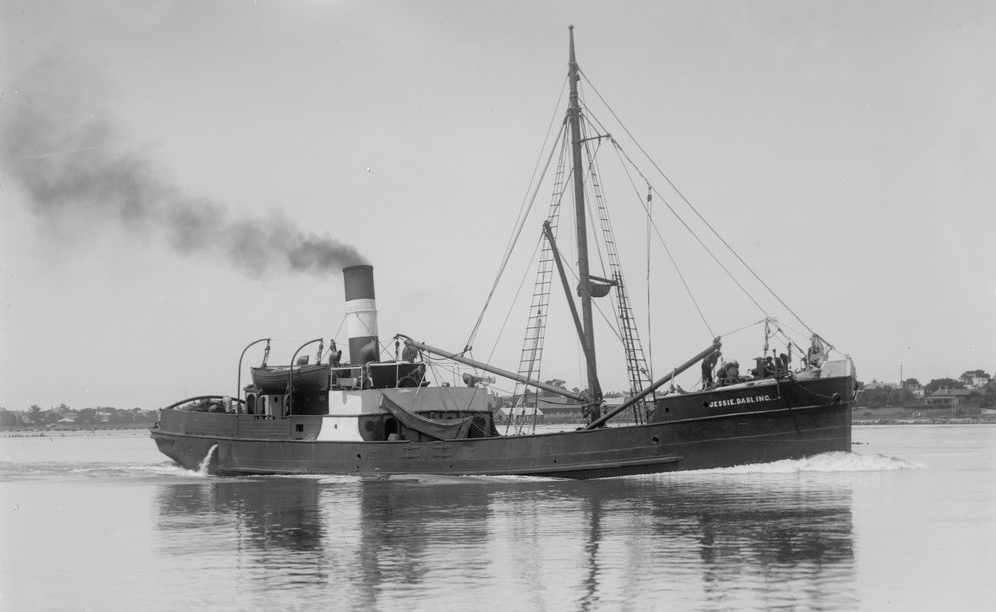
The Steamer "Jessie Darling" first called at Port Germein in June 1885. She was built in 1884 and based in Port Pirie.
Her last visit in 1941 was my first visit; I was her cabin boy, 14 years old and very impressed by the long jetty, very excited too about riding on the old steam engine and looking about the town.We had been running to Tasmania, Melbourne and the many now dead gulf and West Coast ports which were so busy in those days.
The run up the then very beautiful Tamar River to Launceston and my first visit to Germein with its great sailing ship history are among the things which remain vivid in my memory, two vastly different visions, I know - never dreamed that I would settle one day so close to Port Germein and make so many good and wonderful friends in the district. God bless 'em all.
In 1912s "Jessie Darling" ran onto the steel masts of the barque "Norma" which had been sunk off Semaphore in a collision. Poor old "Jessie" sank on top of her. She was later raised, fitted with a large diesel engine and renamed M/V "Coorabie." 'Tis said by those knowledgeable about such matters that she had bugs in the fo'c's'le when she sank and bugs in the fo'c's'le when she was recommissioned; tough bugs in those days, no doubt about it.
"Coorabie" she may have been but she still had "Jessie Darling" 1884 cast into the boss of her large brass-bound wooden steering wheel; she had a long and adventurous life.
Between 28-10-1940 and 7-11-1940 the German raider "Pinguin" and the captured Norwegian tanker "Storstad" renamed "Passat" after her capture and converted to a mine layer at sea, laid over 100 mines around the Southern coast of Australia.
On 7-12-1940 the British steamer "Hertford" (originally "Friesland") which had been captured from Germany in World War 1 struck one of those mines when off Neptune Islands near Port Lincoln. "Coorabie" which was leading at Port Lincoln and the beautiful ketch "Hawke" (built in 1881 and still sailing under her original rig) went to her aid and took off her crew.
"Hertford" was drifting, badly holed in No 2 hold and very low in the water for'ard, towards the reef around the islands.
"Coorabie" put a tow line aboard of her and held her off until tugs arrived and towed her to Port Lincoln. "Hertford" was later taken to Outer Harbour, Port Adelaide where temporary repairs were carried out; she then proceeded to Sydney where she was put back into good condition.
On 29-3-1942 she was 200 miles off Halifax when she was torpedoed and sunk by an Italian submarine; her crew got off in life boats. The submarine surfaced and her captain who must have been a sailor-man and a gentleman of the old school, offered medical assistance, provisions, food, water, a compass and a course to the nearest land if required. he even offered cigarettes. His offers were refused. The life boats contained only hard stale biscuits, water, black chocolate and malted milk tablets.
The crew were rescued within 3-4 days-ships picked them up from two life boats and the other made land. The cold conditions caused great misery and some of the men lost limbs to frost bite.
The "Coorabie" ex "Jessie Darling" was taken over by the government and carried supplies in the Northern Islands and war zone. At the end of World War 2 she was sold to the Netherlands East Indies; her fate is not known.